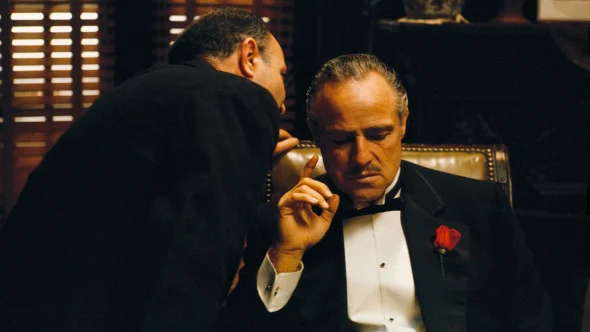
"I love going to the movies, but I don't like to be told what to think or feel by them," Viggo Mortensen muses. "If your story gets my attention during its first 10 or 15 minutes, I'll join you and make the story my own."
Some of the actor and filmmaker's earliest memories are trips to the movie theater with his mother, starting at age 3. "She initiated me in the art of being an active spectator many years ago," he says. "I've seen more movies with her than with anyone else — though not as many as I have seen by myself. She always spoke about movies as stories rather than mere spectacle or entertainment. And after every outing, she would break down these stories. She spoke as much about what had not been shown on the screen as she did about what we'd just seen, and as much or more about what had been left unsaid as about the dialogue we'd just heard."
Mortensen made his film debut with a small role in 1985's Witness and cemented his stardom playing Aragorn in the Oscar-winning The Lord of the Rings trilogy. He has received three Best Actor in a Leading Role Oscar nominations for his performances in Eastern Promises (2007), Captain Fantastic (2016) and Green Book (2018).
In 2020, Mortensen stepped behind the camera to make his directorial debut with the drama Falling. His latest directorial effort is the Western The Dead Don't Hurt, on which Mortensen was also the writer, producer, composer and star.
"When I was a boy, it seemed natural to go and see lots of movies with my mother, and for my mother to offer an in-depth analysis of each one. I know now that most mothers don't do that," he reflects. "Because of her, I have always been fascinated with how movies are constructed, and have been on a constant journey to learn how a scripted story reaches the screen, for better or for worse."
Here, Mortensen shares with A.frame the five films that taught him how to make one himself. "In this space, there is only room for five movies that have taught me something about how to build a movie story, so I offer the following selection off the top of my head, in no particular order, at this moment in time."

Directed by: David Lean | Written by: Robert Bolt and Michael Wilson
I've seen many movies that are well-constructed — and by that I refer to the entire, continuous process of telling a story from screenplay through shooting, editing, sound mixing, grading and scoring. The first movie I remember all of, from start to finish, was David Lean's Lawrence of Arabia. My mother took me to see it for the first time in a huge, 2,500-seat movie house in Buenos Aires when I was 4, and it made a lasting impression on me. Even then, what my mother and I discussed during the intermission, and also at the end of the movie, was how the story was put together.
This movie is written, photographed and edited harmoniously in order to alternate from expansive landscapes and action tableaus to closely observed characters in a smooth narrative about one man's public rise and fall against a complex backdrop of early 20th-century British imperialist machinations and their lasting consequences for the Middle East. Some of editor Anne V. Coates' visual transitions are bold and justly famous, but this is not in any way a frenetically edited movie. From start to finish, this story is made with a sense of containment and discretion, making its well-timed bold flourishes all the more impactful.

Directed by: Carl Theodor Dreyer | Written by: Joseph Delteil and Carl Theodor Dreyer
Perhaps as much as any movie since Edwin S. Porter's 1903 picture The Great Train Robbery, Carl Theodor Dreyer's landmark collaboration with cinematographer Rudolph Maté established a novel narrative approach to movie storytelling. Arguably surpassing the achievements of the finest German expressionist movies, and prefiguring the work of Orson Welles and Gregg Toland in Citizen Kane, Dreyer's masterpiece has endured as a cinematic milestone. As a spectator, each time I have watched this great movie, I have felt like I was being grilled by the inquisitors. The multiple angles of the close-up photography of [Renée Jeanne] Falconetti's face, combined with this performer's uncompromising commitment to a truthful emotional representation of Joan's ordeal, makes for an unforgettably moving viewer experience.
Foreshadowing Citizen Kane, Dreyer often used extreme low-angle shots of Joan's persecutors to make them seem intimidating. Dreyer and Maté accomplished this by placing the camera below ground level at times. There is also frequent use of extreme high-angle and tilted shots, and of disregarding the conventional 180-degree. Dreyer shot in continuity, allowing Falconetti to gradually suffer through the different stages of the trial leading up to her gruesome public execution. It would seem that Dreyer was actively editing his carefully conceived story in linear fashion as he shot it.
It is worth quoting Mordaunt Hall's original review of The Passion of Joan of Arc for the New York Times: "… as a film work of art this takes precedence over anything that has so far been produced. It makes worthy pictures of the past look like tinsel shams. It fills one with such intense admiration that other pictures appear but trivial in comparison."

Written and Directed by: Agnès Varda
It is only in recent years that critics and students of movie history have begrudgingly acknowledged Agnès Varda as the mother of the French New Wave, prefiguring and showing the way to directors like Truffaut, Godard and Chabrol with La Pointe Courte in 1955, and cementing her reputation with Cléo de 5 à 7 in 1962.
This story has a very simple premise: We follow a woman named Cléo, who is a somewhat known pop singer, in real time around Paris while she anxiously awaits the results of a biopsy. In the process, it subtly highlights the oppressive stereotypes that women are relegated to by men. As we join Cléo for variously mundane activities — cab rides, a drink in a café, buying a new hat, a brief meeting with a lover who pays too little attention to her, a conversation with a young soldier about to leave to fight in the Algerian War — we live through her ups and downs between hope and dread, getting an extremely intimate and subversively unpretentious look at one woman as she tries to distract herself during two crucial hours of her life. Owing to the singular way in which images are combined and memory fragments are revealed in the subtly groundbreaking approach to writing, filming and editing that Varda employs, this movie is fashioned in a more understated and consistently compelling way than most of the far more celebrated movies by her New Wave sons.

Directed by: Mario Camus | Written by: Antonio Larreta, Manuel Matji and Mario Camus
The Holy Innocents, directed by Mario Camus and faithfully adapted from the Miguel Delibes novel, might be described as belonging to the genre of humanist realism, in the tradition of Italian neorealist movies, but with a more fluid narrative, less sentimentalism and better photography than the earlier, neorealist movies of precursors De Sica, De Santis, Rossellini and Visconti, among others. Another big difference between them is that this movie, unlike most Italian neorealist productions, employs professional actors across the board, and to great effect. Francisco ("Paco") Rabal and Alfredo Landa are especially brilliant, but the entire cast shines with its authentic portrayals, making this one of the most moving and consistently excellent ensemble performances I have ever seen. Every aspect of this story's construction is an inspiration. One of the finest movies Spain has ever produced.

Directed by: Francis Ford Coppola | Written by: Mario Puzo and Francis Ford Coppola
Every aspect of this movie works optimally for the continuous betterment of the whole. From the complex blueprint that is the script Francis Ford Coppola co-wrote with Mario Puzo, to the bold photography by Gordon Willis, the extraordinary acting by its cast, led by Al Pacino and Marlon Brando, the intricate editing by William Reynolds and Peter Zinner, and the memorable score by Nino Rota, all of the movie storytelling tools work in harmony, steadily creating an atmosphere of intrigue and building dramatic tension from start to finish. There is no finer example in American moviemaking of elegant transitioning from scene to scene without ever losing the story’s overall ideal measures of rhythm and timing.







